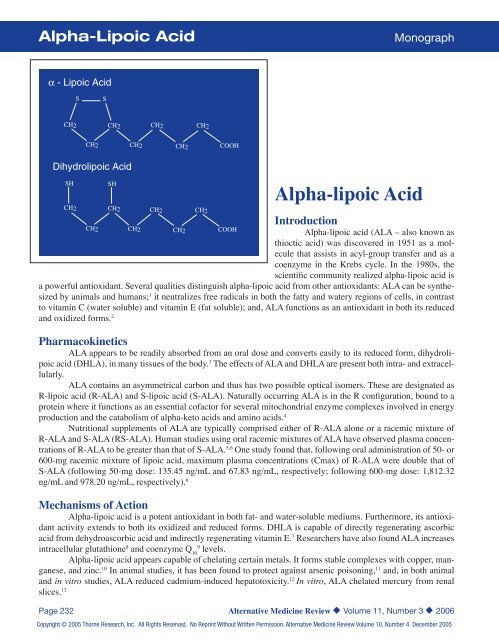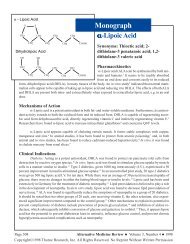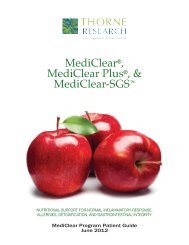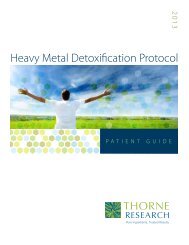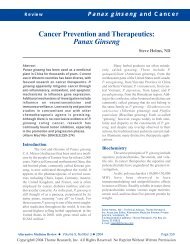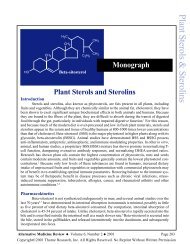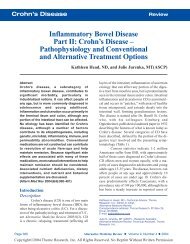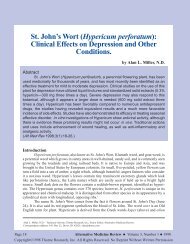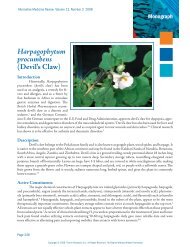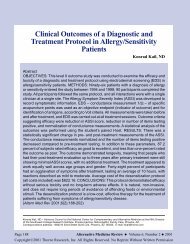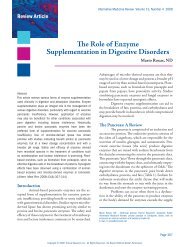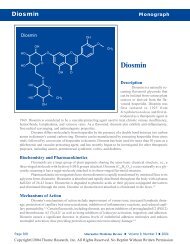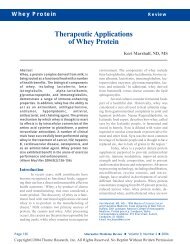Alpha-lipoic Acid - Thorne Research
Alpha-lipoic Acid - Thorne Research
Alpha-lipoic Acid - Thorne Research
You also want an ePaper? Increase the reach of your titles
YUMPU automatically turns print PDFs into web optimized ePapers that Google loves.
<strong>Alpha</strong>-Lipoic <strong>Acid</strong> Monograph<br />
α - Lipoic <strong>Acid</strong><br />
S S<br />
CH2 CH2<br />
CH2 CH2 CH2<br />
Dihydro<strong>lipoic</strong> <strong>Acid</strong><br />
SH<br />
SH<br />
CH2 CH2<br />
CH2<br />
CH2<br />
<strong>Alpha</strong>-<strong>lipoic</strong> <strong>Acid</strong><br />
Introduction<br />
<strong>Alpha</strong>-<strong>lipoic</strong> acid (ALA – also known as<br />
thioctic acid) was discovered in 1951 as a molecule<br />
that assists in acyl-group transfer and as a<br />
coenzyme in the Krebs cycle. In the 1980s, the<br />
scientific community realized alpha-<strong>lipoic</strong> acid is<br />
a powerful antioxidant. Several qualities distinguish alpha-<strong>lipoic</strong> acid from other antioxidants: ALA can be synthesized<br />
by animals and humans; 1 it neutralizes free radicals in both the fatty and watery regions of cells, in contrast<br />
to vitamin C (water soluble) and vitamin E (fat soluble); and, ALA functions as an antioxidant in both its reduced<br />
and oxidized forms. 2<br />
CH2 CH2 CH2 COOH<br />
Pharmacokinetics<br />
ALA appears to be readily absorbed from an oral dose and converts easily to its reduced form, dihydro<strong>lipoic</strong><br />
acid (DHLA), in many tissues of the body. 3 The effects of ALA and DHLA are present both intra- and extracellularly.<br />
ALA contains an asymmetrical carbon and thus has two possible optical isomers. These are designated as<br />
R-<strong>lipoic</strong> acid (R-ALA) and S-<strong>lipoic</strong> acid (S-ALA). Naturally occurring ALA is in the R configuration, bound to a<br />
protein where it functions as an essential cofactor for several mitochondrial enzyme complexes involved in energy<br />
production and the catabolism of alpha-keto acids and amino acids. 4<br />
Nutritional supplements of ALA are typically comprised either of R-ALA alone or a racemic mixture of<br />
R-ALA and S-ALA (RS-ALA). Human studies using oral racemic mixtures of ALA have observed plasma concentrations<br />
of R-ALA to be greater than that of S-ALA. 5,6 One study found that, following oral administration of 50- or<br />
600-mg racemic mixture of <strong>lipoic</strong> acid, maximum plasma concentrations (Cmax) of R-ALA were double that of<br />
S-ALA (following 50-mg dose: 135.45 ng/mL and 67.83 ng/mL, respectively; following 600-mg dose: 1,812.32<br />
ng/mL and 978.20 ng/mL, respectively). 6<br />
Mechanisms of Action<br />
<strong>Alpha</strong>-<strong>lipoic</strong> acid is a potent antioxidant in both fat- and water-soluble mediums. Furthermore, its antioxidant<br />
activity extends to both its oxidized and reduced forms. DHLA is capable of directly regenerating ascorbic<br />
acid from dehydroascorbic acid and indirectly regenerating vitamin E. 7 <strong>Research</strong>ers have also found ALA increases<br />
intracellular glutathione 8 and coenzyme Q 10<br />
CH2<br />
CH2<br />
9 levels.<br />
COOH<br />
<strong>Alpha</strong>-<strong>lipoic</strong> acid appears capable of chelating certain metals. It forms stable complexes with copper, manganese,<br />
and zinc. 10 In animal studies, it has been found to protect against arsenic poisoning, 11 and, in both animal<br />
and in vitro studies, ALA reduced cadmium-induced hepatotoxicity. 12 In vitro, ALA chelated mercury from renal<br />
slices. 13<br />
Page 232 Alternative Medicine Review u Volume 11, Number 3 u 2006<br />
Copyright © 2005 <strong>Thorne</strong> <strong>Research</strong>, Inc. All Rights Reserved. No Reprint Without Written Permission. Alternative Medicine Review Volume 10, Number 4 December 2005
Monograph <strong>Alpha</strong>-Lipoic <strong>Acid</strong><br />
Mechanisms that may account for <strong>lipoic</strong><br />
acid’s benefit in preventing diabetic complications<br />
include prevention of protein glycosylation 14 and inhibition<br />
of the enzyme aldose reductase, the latter of<br />
which subsequently inhibits conversion of glucose<br />
and galactose to sorbitol. 15,16 Accumulation of sorbitol<br />
has been implicated in the pathogenesis of various<br />
diabetic complications, including “sugar cataracts”<br />
where sorbitol accumulates in the lens.<br />
Clinical Indications<br />
Diabetes<br />
Lipoic acid has the potential to prevent diabetes<br />
(at least in animals), influence glucose control,<br />
and prevent chronic hyperglycemia-associated complications<br />
such as neuropathy.<br />
Blood-sugar Management/Insulin Sensitivity<br />
Acting as a potent antioxidant, DHLA protected<br />
rat pancreatic islet cells from destruction by<br />
reactive oxygen species. 17 In vitro, <strong>lipoic</strong> acid stimulated<br />
glucose uptake by muscle cells in a manner<br />
similar to insulin. 18<br />
Type 2 diabetics given 1,000 mg <strong>lipoic</strong> acid<br />
intravenously (IV) experienced a 50-percent improvement<br />
in insulin-stimulated glucose uptake. 19 In<br />
an uncontrolled pilot study, 20 type 2 diabetics were<br />
given 500 mg <strong>lipoic</strong> acid IV for 10 days. While there<br />
was an average 30-percent increased uptake of glucose,<br />
there were no changes in fasting blood sugar or<br />
insulin levels. 20<br />
In a study examining the effect of <strong>lipoic</strong> acid<br />
as a co-factor of the pyruvate dehydrogenase complex<br />
on both lean and obese type 2 diabetics, insulin<br />
sensitivity, glucose effectiveness, serum lactate levels,<br />
and pyruvate levels were tested after oral glucose<br />
tolerance load. Treatment with 600 mg ALA twice<br />
daily for four weeks increased insulin sensitivity and<br />
prevented serum lactate/pyruvate-induced hyperglycemia.<br />
21<br />
In a placebo-controlled, multi-center pilot<br />
study, 74 patients with type 2 diabetes were randomized<br />
to receive 600 mg ALA or placebo orally once,<br />
twice, or three times daily, for four weeks. Although<br />
no significant differences regarding the various doses<br />
of ALA were observed, at the end of the trial it was<br />
found that patients who received ALA experienced<br />
significant improvement in insulin-stimulated glucose<br />
disposal compared to those on placebo (+27%;<br />
p
<strong>Alpha</strong>-Lipoic <strong>Acid</strong> Monograph<br />
months; 600 mg IV ALA daily for three weeks, followed<br />
by placebo three times daily for six months;<br />
or double placebo. While no significant differences<br />
were noted in subjective symptom evaluation among<br />
the groups, treatment with ALA was associated with<br />
improvement in nerve function. 27<br />
In one randomized, double-blind, placebocontrolled<br />
study, known as the SYDNEY trial, 60<br />
type 2 diabetic patients with diabetic sensorimotor<br />
polyneuropathy (DSPN) were administered 600 mg<br />
IV ALA daily, five days/week for a total of 14 treatments,<br />
while an equivalent number of DSPN patients<br />
were given placebo for the same duration. At the end<br />
of the trial, the ALA group reported significant improvement<br />
in overall symptoms (e.g., lancinating and<br />
burning pain, numbness, and tingling) compared to<br />
the placebo group (average decrease in total symptom<br />
score (TSS): 5.7 versus 1.8) (p
Monograph <strong>Alpha</strong>-Lipoic <strong>Acid</strong><br />
Cognitive Function<br />
<strong>Alpha</strong>-<strong>lipoic</strong> acid may have a positive effect<br />
on patients with Alzheimer’s disease and other types<br />
of memory dysfunction secondary to trauma or cerebral<br />
vascular accident. By decreasing oxidative damage<br />
in the central nervous system, ALA may decrease<br />
the severity of central nervous system disorders. 2<br />
An animal study has shown supplementation<br />
with <strong>lipoic</strong> acid improves long-term memory in aged<br />
mice; however, no effect in young mice was shown. 45<br />
This lack of treatment effect in young mice suggests<br />
ALA does not improve memory from a general standpoint;<br />
instead, it appears ALA compensates for agerelated<br />
memory deficits.<br />
<strong>Alpha</strong>-<strong>lipoic</strong> acid also appears to protect brain<br />
cells from the damaging effects of some hazardous<br />
chemicals. <strong>Research</strong>ers at the University of Rochester<br />
reported neuron damage from excess N-methyl-D-aspartate<br />
was prevented by <strong>lipoic</strong> acid. 46 Another study<br />
found buthionine sulfoximine-stimulated neurotoxicity<br />
in rat brain was partially prevented by R-ALA, but<br />
not RS-ALA, S-ALA, or RS-DHLA. 47<br />
Heavy Metal Toxicity<br />
In vitro and animal studies suggest <strong>lipoic</strong><br />
acid supplementation might be a beneficial component<br />
in the treatment of heavy metal toxicity, particularly<br />
toxicity involving lead, cadmium, mercury, or<br />
copper. 2,48-53 In one study an intraperitoneal injection<br />
of 25 mg/kg ALA given to rats for seven days was<br />
able to significantly alter the oxidative stress induced<br />
by lead toxicity. 48 Another study demonstrated ALA,<br />
at concentrations of 5 mM, was able to protect rat<br />
hepatocytes from cadmium toxicity (200 µM) by preventing<br />
decreases in total glutathione and increases in<br />
lipid peroxidation. 49 Furthermore, a study on mercury<br />
intoxication revealed an injection of 10 mg/kg/day<br />
ALA in rats inoculated with 1 mg/kg/day mercuric<br />
chloride prevented damage to nerve tissue caused<br />
by lipid peroxidation. 52 Long-Evans Cinnamon rats<br />
have a genetic defect that causes them to accumulate<br />
copper in the liver – in a manner similar to patients<br />
with Wilson’s disease – and spontaneously develop<br />
acute hepatitis. ALA has been shown to protect<br />
these rats from developing hepatitis. 53 ALA appears<br />
to improve tissue redox status in metal toxicity and<br />
during chelation with dithiol compounds, including<br />
dimercaptosuccinic acid (DMSA). 54 Anecdotal reports<br />
note the use of <strong>lipoic</strong> acid may improve the<br />
clearance of toxic metals.<br />
Other Indications<br />
Other therapeutic uses for ALA or DHLA<br />
include protection from radiation injury and prevention<br />
of HIV viral replication by inhibition of reverse<br />
transcriptase and nuclear factor kappa-B (a protein<br />
that functions as a nuclear transcription factor and<br />
appears to play a role in inflammation). 55,56<br />
Side Effects and Toxicity<br />
<strong>Alpha</strong>-<strong>lipoic</strong> acid appears to be safe in dosages<br />
generally prescribed clinically. The LD 50 was<br />
400-500 mg/kg after an oral dosage in dogs; 2 however,<br />
lower dosages (20 mg/kg) given intraperitoneally<br />
to severely thiamine-deficient rats proved fatal.<br />
These adverse effects were prevented when thiamine<br />
was administered with <strong>lipoic</strong> acid. 57 Anecdotal evidence<br />
suggests ALA may be hepatotoxic to cats at<br />
doses greater than 20 mg daily. There have not been<br />
sufficient studies to guarantee safe use in pregnancy.<br />
Allergic skin conditions are among the few reported<br />
side effects of <strong>lipoic</strong> acid administration in humans.<br />
Dosage Recommended oral therapeutic dosages of<br />
alpha-<strong>lipoic</strong> acid range from 600-1800 mg daily. Because<br />
R-<strong>lipoic</strong> acid is more efficiently absorbed and<br />
utilized by the body, R-ALA may be equally effective<br />
at lower doses.<br />
References<br />
1. Carreau JP. Biosynthesis of <strong>lipoic</strong> acid via<br />
unsaturated fatty acids. Methods Enzymol<br />
1979;62:152-158.<br />
2. Packer L, Witt EH, Tritschler HJ. <strong>Alpha</strong>-<strong>lipoic</strong> acid<br />
as a biological antioxidant. Free Radic Biol Med<br />
1995;19:227-250.<br />
3. Handelman GJ, Han D, Tritschler H, Packer L.<br />
<strong>Alpha</strong>-<strong>lipoic</strong> acid reduction by mammalian cells<br />
to the dithiol form and release into the culture<br />
medium. Biochem Pharmacol 1994;47:1725-1730.<br />
4. Bustamante J, Lodge JK, Marcocci L, et al. <strong>Alpha</strong><strong>lipoic</strong><br />
acid in liver metabolism and disease. Free<br />
Radic Biol Med 1998;24;6:1023-1039.<br />
Alternative Medicine Review u Volume 11, Number 3 u 2006 Page 235<br />
Copyright © 2005 <strong>Thorne</strong> <strong>Research</strong>, Inc. All Rights Reserved. No Reprint Without Written Permission. Alternative Medicine Review Volume 10, Number 4 December 2005
<strong>Alpha</strong>-Lipoic <strong>Acid</strong> Monograph<br />
5. Hermann R, Niebch G, Borbe HO, et al.<br />
Enantioselective pharmacokinetics and<br />
bioavailability of different racemic α-<strong>lipoic</strong> acid<br />
formulations in healthy volunteers. Eur J Pharm<br />
Sci 1996;4:167-174.<br />
6. Breithaupt-Grogler K, Niebch G, Schneider E,<br />
et al. Dose-proportionality of oral thioctic acid<br />
– coincidence of assessments via pooled plasma<br />
and individual data. Eur J Pharm Sci 1999;8:57-65.<br />
7. Scholich H, Murphy ME, Sies H. Antioxidant<br />
activity of dihydrolipoate against microsomal<br />
lipid peroxidation and its dependence on alphatocopherol.<br />
Biochem Biophys Acta 1989;1001:256-<br />
261.<br />
8. Busse E, Zimmer G, Schopohl B, Kornhuber<br />
B. Influence of alpha-<strong>lipoic</strong> acid on<br />
intracellular glutathione in vitro and in vivo.<br />
Arzneimittelforschung 1992;42:829-831.<br />
9. Kagan V, Serbinova E, Packer L. Antioxidant<br />
effects of ubiquinones in microsomes and<br />
mitochondria are mediated by tocopherol recycling.<br />
Biochem Biophys Res Commun 1990;169:851-857.<br />
10. Sigel H, Prijs B, McCormick DB, Shih JC. Stability<br />
and structure of binary and ternary complexes of<br />
alpha-lipoate and lipoate derivatives with Mn2 + ,<br />
Cu2 + , and Zn2 + in solution. Arch Biochem Biophys<br />
1978;187:208-214.<br />
11. Grunert RR. The effect of DL alpha-<strong>lipoic</strong> acid on<br />
heavy-metal intoxication in mice and dogs. Arch<br />
Biochem Biophys 1960;86:190-194.<br />
12. Muller L, Menzel H. Studies on the efficacy of<br />
lipoate and dihydrolipoate in the alteration of<br />
cadmium2+ toxicity in isolated hepatocytes.<br />
Biochim Biophys Acta 1990;1052:386-391.<br />
13. Keith RL, Setiarahardjo I, Fernando Q, et al.<br />
Utilization of renal slices to evaluate the efficacy<br />
of chelating agents for removing mercury from the<br />
kidney. Toxicology 1997;116:67-75.<br />
14. Schleicher ED, Wagner E, Nerlich AG. Increased<br />
accumulation of the glycoxidation product<br />
N(epsilon)-(carboxymethyl)lysine in human tissues<br />
in diabetes and aging. J Clin Invest 1997;99:457-<br />
468.<br />
15. Ou P, Nourooz-Zadeh J, Tritschler HJ, Wolff S.<br />
Activation of aldose reductase in rat lens and metalion<br />
chelation by aldose reductase inhibitors and<br />
<strong>lipoic</strong> acid. Free Radic Res 1996;25:337-346.<br />
16. Kishi Y, Schmelzer JD, Yao JK, et al. <strong>Alpha</strong>-<strong>lipoic</strong><br />
acid: effect on glucose uptake, sorbitol pathway,<br />
and energy metabolism in experimental diabetic<br />
neuropathy. Diabetes 1999;48;2045-2051.<br />
17. Heller B, Burkhart V, Lampeter E, Kolb H.<br />
Antioxidant therapy for the prevention of type 1<br />
diabetes. Adv Pharmacol 1997;38:629-638.<br />
18. Estrada DE, Ewart HS, Tsakiridis T, et al.<br />
Stimulation of glucose uptake by the natural<br />
coenzyme alpha-<strong>lipoic</strong> acid/thioctic acid:<br />
participation of elements of the insulin signaling<br />
pathway. Diabetes 1996;45:1798-1804.<br />
19. Jacob S, Henriksen EJ, Schiemann AL, et al.<br />
Enhancement of glucose disposal in patients<br />
with type 2 diabetes by alpha-<strong>lipoic</strong> acid.<br />
Arzneimittelforschung 1995;45:872-874.<br />
20. Jacob S, Henriksen EJ, Tritschler HJ, et al.<br />
Improvement of insulin-stimulated glucosedisposal<br />
in type 2 diabetes after repeated parenteral<br />
administration of thioctic acid. Exp Clin Endocrinol<br />
Diabetes 1996;104:284-288.<br />
21. Konrad T, Vicini P, Kusterer K, et al. <strong>Alpha</strong>-<strong>lipoic</strong><br />
acid treatment decreases serum lactate and pyruvate<br />
concentrations and improves glucose effectiveness<br />
in lean and obese patients with type 2 diabetes.<br />
Diabetes Care 1999;22:280-287.<br />
22. Jacob S, Ruus P, Hermann R, et al. Oral<br />
administration of RAC-alpha-<strong>lipoic</strong> acid modulates<br />
insulin sensitivity in patients with type-2 diabetes<br />
mellitus: a placebo-controlled pilot trial. Free Radic<br />
Biol Med 1999;27:309-314.<br />
23. Streeper RS, Henriksen EJ, Jacob S, et al.<br />
Differential effects of <strong>lipoic</strong> acid stereoisomers on<br />
glucose metabolism in insulin-resistant skeletal<br />
muscle. Am J Physiol 1997;273:E185-E191.<br />
24. Melhem MF, Craven PA, Derubertis FR. Effects<br />
of dietary supplementation of alpha-<strong>lipoic</strong> acid on<br />
early glomerular injury in diabetes mellitus. J Am<br />
Soc Nephrol 2001;12:124-133.<br />
25. Ziegler D, Hanefeld M, Ruhnau KJ, et al.<br />
Treatment of symptomatic diabetic peripheral<br />
neuropathy with the anti-oxidant alpha-<strong>lipoic</strong> acid.<br />
A 3-week multicentre randomized controlled trial<br />
(ALADIN Study). Diabetologia 1995;38:1425-<br />
1433.<br />
26. Reljanovic M, Reichel G, Rett K, et al. Treatment<br />
of diabetic polyneuropathy with the antioxidant<br />
thioctic acid (alpha-<strong>lipoic</strong> acid): a two year<br />
multicenter randomized double-blind placebocontrolled<br />
trial (ALADIN II). <strong>Alpha</strong> Lipoic <strong>Acid</strong> In<br />
Diabetic Neuropathy. Free Radic Res 1999;31:171-<br />
179.<br />
27. Ziegler D, Hanefeld M, Ruhnau KJ, et al.<br />
Treatment of symptomatic diabetic polyneuropathy<br />
with the antioxidant alpha-<strong>lipoic</strong> acid: a 7-month<br />
multicenter randomized controlled trial (ALADIN<br />
III Study). ALADIN III Study Group. <strong>Alpha</strong>-<br />
Lipoic <strong>Acid</strong> in Diabetic Neuropathy. Diabetes Care<br />
1999;22:1296-1301.<br />
28. Ametov AS, Barinov A, Dyck PJ, et al. The sensory<br />
symptoms of diabetic polyneuropathy are improved<br />
with alpha-<strong>lipoic</strong> acid: the SYDNEY trial. Diabetes<br />
Care 2003;26:770-776.<br />
29. Ruhnau KJ, Meissner HP, Finn JR, et al. Effects of<br />
3-week oral treatment with the antioxidant thioctic<br />
acid (alpha-<strong>lipoic</strong> acid) in symptomatic diabetic<br />
polyneuropathy. Diabet Med 1999;16:1040-1043.<br />
30. Nickander KK, McPhee BR, Low PA, Tritschler<br />
H. <strong>Alpha</strong>-<strong>lipoic</strong> acid: antioxidant potency against<br />
lipid peroxidation of neural tissues in vitro and<br />
implications for diabetic neuropathy. Free Radic<br />
Biol Med 1996;21:631-639.<br />
Page 236 Alternative Medicine Review u Volume 11, Number 3 u 2006<br />
Copyright © 2005 <strong>Thorne</strong> <strong>Research</strong>, Inc. All Rights Reserved. No Reprint Without Written Permission. Alternative Medicine Review Volume 10, Number 4 December 2005
Monograph <strong>Alpha</strong>-Lipoic <strong>Acid</strong><br />
31. Kahler W, Kuklinski B, Ruhlmann C, Plotz C.<br />
Diabetes mellitus – a free radical-associated<br />
disease. Results of adjuvant antioxidant<br />
supplementation. Z Gesamte Inn Med 1993;48:223-<br />
232. [Article in German]<br />
32. Ziegler D, Schatz H, Contrad F, et al. Effects of<br />
treatment with the antioxidant alpha-<strong>lipoic</strong> acid on<br />
cardiac autonomic neuropathy in NIDDM patients.<br />
A 4-month randomized controlled multicenter trial<br />
(DEKAN Study). Deutsche Kardiale Autonome<br />
Neuropathie. Diabetes Care 1997;20:369-373.<br />
33. Maitra I, Serbinova E, Tritschler H, Packer L.<br />
<strong>Alpha</strong>-<strong>lipoic</strong> acid prevents buthionine sulfoximineinduced<br />
cataract formation in newborn rats. Free<br />
Rad Biol Med 1995;18:823-829.<br />
34. Maitra I, Serbinova E, Tritschler HJ, Packer L.<br />
Stereospecific effects of R-<strong>lipoic</strong> acid on buthionine<br />
sulfoximine-induced cataract formation in newborn<br />
rats. Biochem Biophys Res Commun 1996;221:422-<br />
429.<br />
35. Filina AA, Davydova NG, Endrikhovskii SN,<br />
Shamshinova AM. Lipoic acid as a means of<br />
metabolic therapy of open-angle glaucoma. Vestn<br />
Oftalmol 1995;111:6-8. [Article in Russian]<br />
36. Scheer B, Zimmer G. Dihydro<strong>lipoic</strong> acid prevents<br />
hypoxic/reoxygenation and peroxidative damage<br />
in rat mitochondria. Arch Biochem Biophys<br />
1993;302:385-390.<br />
37. Assadnazari H, Zimmer G, Freisleben HJ, et<br />
al. Cardioprotective efficiency of dihydro<strong>lipoic</strong><br />
acid in working rat hearts during hypoxia and<br />
reoxygenation. 31P nuclear magnetic resonance<br />
investigations. Arzneimittelforschung 1993;43:425-<br />
432.<br />
38. Prehn JH, Karkoutly C, Nuglisch J, et al.<br />
Dihydrolipoate reduces neuronal injury after<br />
cerebral ischemia. J Cereb Blood Flow Metab<br />
1992;12:78-87.<br />
39. Panigrahi M, Sadguna Y, Shivakumar BR, et al.<br />
<strong>Alpha</strong>-<strong>lipoic</strong> acid protects against reperfusion<br />
injury following cerebral ischemia in rats. Brain<br />
Res 1996;717:184-188.<br />
40. Cao X, Phillis JW. The free radical scavenger,<br />
alpha-<strong>lipoic</strong> acid, protects against cerebral<br />
ischemia-reperfusion injury in gerbils. Free Rad<br />
Res 1995;23:365-370.<br />
41. Mitsui Y, Schmelzer JD, Zollman PJ, et al. <strong>Alpha</strong><strong>lipoic</strong><br />
acid provides neuroprotection from ischemiareperfusion<br />
injury of peripheral nerve. J Neurol Sci<br />
1999;163:11-16.<br />
42. Haramaki N, Assadnazari H, Zimmer G, et al.<br />
The influence of vitamin E and dihydro<strong>lipoic</strong> acid<br />
on cardiac energy and glutathione status under<br />
hypoxia-reoxygenation. Biochem Mol Biol Int<br />
1995;37:591-597.<br />
43. Bartter FC, Berkson BM, Gallelli J, et al. Thioctic<br />
acid in the treatment of poisoning with alphaamanitin.<br />
In: Faulstich H, Kommerell B, Wieland T,<br />
eds. Amanita Toxins and Poisoning. Baden-Baden,<br />
Germany: Verlg Gerhard Witzstrock; 1980:197-<br />
202.<br />
44. Marshall AW, Graul RS, Morgan MY, Sherlock<br />
S. Treatment of alcohol-related liver disease with<br />
thioctic acid: a six month randomised double-blind<br />
trial. Gut 1982;23:1088-1093.<br />
45. Stoll S, Hartmann H, Cohen SA, Muller WE.<br />
The potent free radical scavenger alpha-<strong>lipoic</strong><br />
acid improves memory in aged mice: putative<br />
relationship to NMDA receptor deficits. Pharmacol<br />
Biochem Behav 1993;46:799-805.<br />
46. Greenamyre JT, Garcia-Osuna M, Greene JG.<br />
The endogenous cofactors, thioctic acid and<br />
dihydro<strong>lipoic</strong> acid, are neuroprotective against<br />
NMDA and malonic acid lesions of striatum.<br />
Neurosci Lett 1994;171:17-20.<br />
47. Lockhart B, Jones C, Cuisinier C, et al.<br />
Inhibition of L-homocysteic acid and buthionine<br />
sulphoximine-mediated neurotoxicity in rat<br />
embryonic neuronal cultures with alpha-<strong>lipoic</strong> acid<br />
enantiomers. Brain Res 2000;855:292-297.<br />
48. Gurer H, Ozgunes H, Oztezcan S, Ercal N.<br />
Antioxidant role of alpha-<strong>lipoic</strong> acid in lead<br />
toxicity. Free Radic Biol Med 1999;27:75-81.<br />
49. Muller L, Menzel H. Studies on the efficacy of<br />
lipoate and dihydrolipoate in the alteration of<br />
cadmium2+ toxicity in isolated hepatocytes.<br />
Biochem Biophys Acta 1990;1052:386-391.<br />
50. Muller L. Protective effects of DL-alpha-<strong>lipoic</strong><br />
acid on cadmium-induced deterioration of rat<br />
hepatocytes. Toxicology 1989;58:175-185.<br />
51. Sumathi R, Baskaran G, Varalakshmi P.<br />
Relationship between glutathione and DL<br />
alpha-<strong>lipoic</strong> acid against cadmium-induced<br />
hepatotoxicity. Jpn J Med Sci Biol 1996;49:39-48.<br />
52. Anuradha B, Varalakshmi P. Protective role of DLalpha-<strong>lipoic</strong><br />
acid against mercury-induced neural<br />
lipid peroxidation. Pharmacol Res 1999;39:67-80.<br />
53. Yamamoto H, Watanabe T, Mizuno H, et al. The<br />
antioxidant effect of DL-alpha-<strong>lipoic</strong> acid on<br />
copper-induced acute hepatitis in Long-Evans<br />
Cinnamon (LEC) rats. Free Radic Res 2001;34:69-<br />
80.<br />
54. Pande M, Flora SJ. Lead induced oxidative damage<br />
and its response to combined administration of<br />
alpha-<strong>lipoic</strong> acid and succimers in rats. Toxicology<br />
2002;177:187-196.<br />
55. Baur A, Harrer T, Peukert M, et al. <strong>Alpha</strong>-<strong>lipoic</strong><br />
acid is an effective inhibitor of human immunodeficiency<br />
virus (HIV-1) replication. Klin<br />
Wochenschr 1991;69:722-724.<br />
56. Suzuki YJ, Aggarwal BB, Packer L. <strong>Alpha</strong>-<strong>lipoic</strong><br />
acid is a potent inhibitor of NF-kappa B activation<br />
in human T-cells. Biochem Biophys Res Commun<br />
1992;189:1709-1715.<br />
57. Gal EM. Reversal of selective toxicity of (-)-alpha<strong>lipoic</strong><br />
acid by thiamine in thiamine-deficient rats.<br />
Nature 1965;207:535.<br />
Alternative Medicine Review u Volume 11, Number 3 u 2006 Page 237<br />
Copyright © 2005 <strong>Thorne</strong> <strong>Research</strong>, Inc. All Rights Reserved. No Reprint Without Written Permission. Alternative Medicine Review Volume 10, Number 4 December 2005


